Paper Menu >>
Journal Menu >>
 Vol.3, No.3, 135-140 (2011) Health doi:10.4236/health.2011.33025 Copyright © 2011 SciRes. Openly accessible at http://www.scirp.org/journal/HEALTH/ Prevalence and characterization of supplement use among healthy children and adolescents in an urban Japanese city Nagisa Mori, Masaru Kubota*, Shoko Hamada, Ayako Nagai Department of Human Life and Environment, Nara Women’s University, Nara, Japan; *Corresponding Author: masaru_kubota@chime.ocn.ne.jp Received 2 January 2011; revised 20 February 2011, accepted 28 February 2011. ABSTRACT Although there a re numerous studies on the use of supplements in children and adolescents from western countries, only a small number of studies have been conducted in Asian countrie s. This study was planned to determine the use of supplements and their association with life- styles in healthy Japanese children and ado- lescents. This is a community-based cross-sec- tional study conducted i n a Jap anes e urban city, Nara, in 2008. A total of 681 children and ado- lescents aged between 3 and 17 years were en- rolled. The parents were asked to complete a questionnaire on the use of supplement s among their children. Demographic information, health and nutrition status of children as perceived by parents, sleep duration, and a family history of supplement use were also collected. A total of 20.4% of children and adolescents are presently using (in the past one month) or have used (in the p as t one y ear excluding the past one month) supplements. The types of supplements most commonly used were minerals, followed by vi- tamins and blueberry extracts. Univariate analy- sis indicated that supplement use was associ- ated with older age, poor perception of health status, shorter sleep duration, and a positive family history of supplement use. Multiple lo- gistic regression analysis showed that age and a positive family history affected supplement use. Given the approximately 20% of prevalence of supplement use in Japanese children and adolescents, there is a need for further research to examine the supplements’ effectiveness and safety. Keywords: Supplement; Child; Adolescence; Japan; Lifestyle 1. INTRODUCTION The use of supplements is expanding rapidly because of a growing worldwide awareness of health promotion [1]. The actual prevalence of supplement use differs greatly from country to country, presumably due to the diversity of cultural, nutritional, and economic condi- tions. A series of nationwide surveys in the United States indicated that the rates of supplement use in adults aged 18 years or older ranged from 32 to 52% [2-5]. In Euro- pean [6,7] and Asian [8,9] countries, the reported rates were lower, i.e. approximately between 15 and 30%. These reports have also identified the characteristics of supplement users from cultural, economic, and nutri- tional points of view. In contrast, little is known about the prevalence of supplement use in children and ado- lescents except in the United States, where as high as approximately 30-50% of children and adolescents have been reported to use supplements [10-13]. Small cohort studies from Europe showed that the frequencies of sup- plement use were 25.8% for German children and ado- lescents [14], and 37-50% for Finnish children aged 2 and 3 years [15]. The only comprehensive report on sup- plement use in children in Asian countries, as far as we know, was the investigation carried out by the National Institute of Health and Nutrition in Japan, which found that 15% of preschool children used supplements [16]. However, this survey only targeted preschool children. Therefore, the purpose of the present study is to deter- mine the prevalence of supplement use in healthy Japa- nese children and adolescents, and to consider the rela- tionships between supplement use and demographic and lifestyle factors. 2. MATERIALS AND METHODS 2.1. Study Design and Subjects This study was done in Nara city from April to May in 2008. Nara is an urban city in Japan with a population of 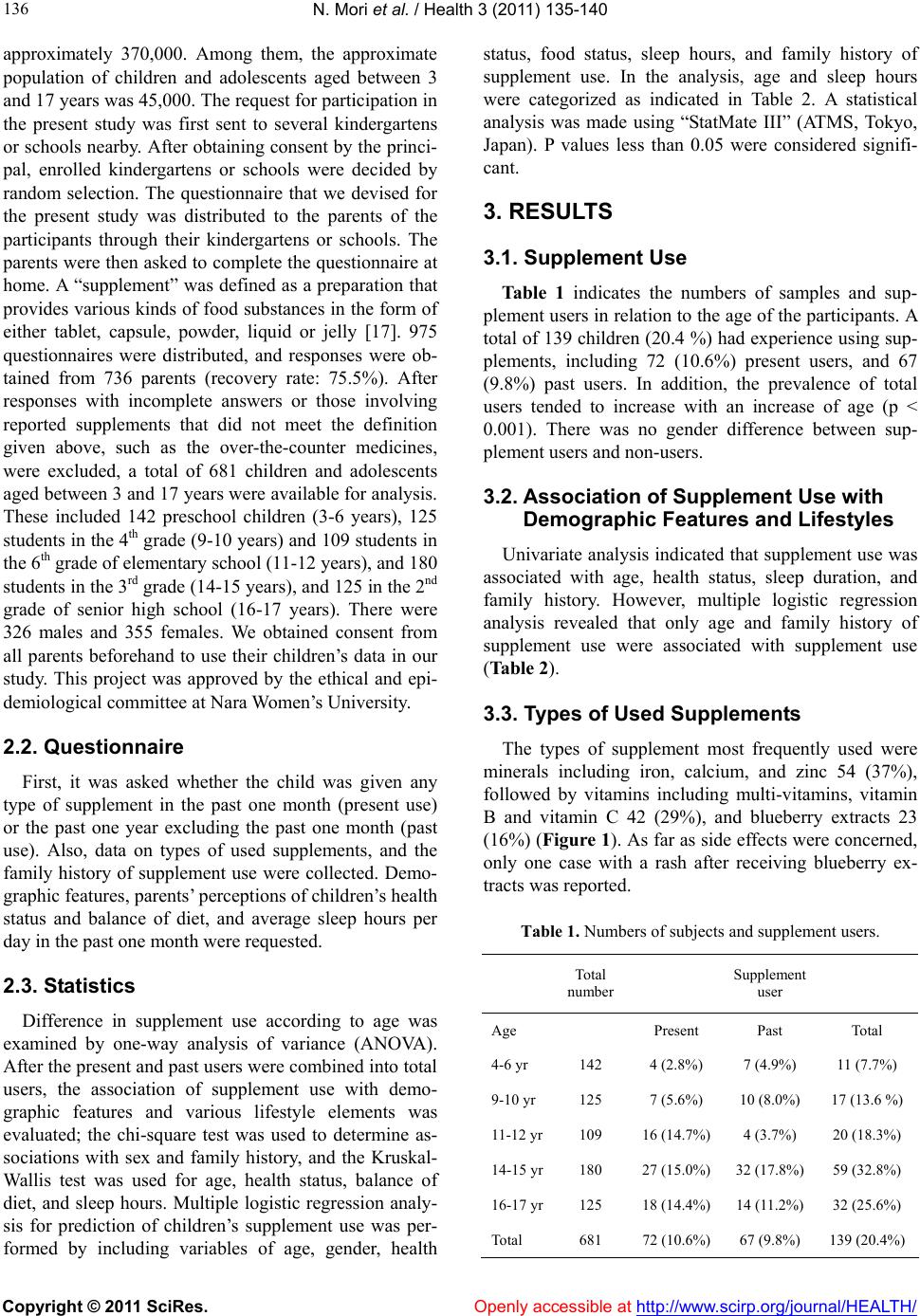 N. Mori et al. / Health 3 (2011) 135-140 Copyright © 2011 SciRes. Openly accessible at http://www.scirp.org/journal/HEALTH/ 136 approximately 370,000. Among them, the approximate population of children and adolescents aged between 3 and 17 years was 45,000. The request for participation in the present study was first sent to several kindergartens or schools nearby. After obtaining consent by the princi- pal, enrolled kindergartens or schools were decided by random selection. The questionnaire that we devised for the present study was distributed to the parents of the participants through their kindergartens or schools. The parents were then asked to complete the questionnaire at home. A “supplement” was defined as a preparation that provides various kinds of food substances in the form of either tablet, capsule, powder, liquid or jelly [17]. 975 questionnaires were distributed, and responses were ob- tained from 736 parents (recovery rate: 75.5%). After responses with incomplete answers or those involving reported supplements that did not meet the definition given above, such as the over-the-counter medicines, were excluded, a total of 681 children and adolescents aged between 3 and 17 years were available for analysis. These included 142 preschool children (3-6 years), 125 students in the 4th grade (9-10 years) and 109 students in the 6th grade of elementary school (11-12 years), and 180 students in the 3rd grade (14-15 years), and 125 in the 2nd grade of senior high school (16-17 years). There were 326 males and 355 females. We obtained consent from all parents beforehand to use their children’s data in our study. This project was approved by the ethical and epi- demiological committee at Nara Women’s University. 2.2. Questionnaire First, it was asked whether the child was given any type of supplement in the past one month (present use) or the past one year excluding the past one month (past use). Also, data on types of used supplements, and the family history of supplement use were collected. Demo- graphic features, parents’ perceptions of children’s health status and balance of diet, and average sleep hours per day in the past one month were requested. 2.3. Statistics Difference in supplement use according to age was examined by one-way analysis of variance (ANOVA). After the present and past users were combined into total users, the association of supplement use with demo- graphic features and various lifestyle elements was evaluated; the chi-square test was used to determine as- sociations with sex and family history, and the Kruskal- Wallis test was used for age, health status, balance of diet, and sleep hours. Multiple logistic regression analy- sis for prediction of children’s supplement use was per- formed by including variables of age, gender, health status, food status, sleep hours, and family history of supplement use. In the analysis, age and sleep hours were categorized as indicated in Table 2. A statistical analysis was made using “StatMate III” (ATMS, Tokyo, Japan). P values less than 0.05 were considered signifi- cant. 3. RESULTS 3.1. Supplement Use Table 1 indicates the numbers of samples and sup- plement users in relation to the age of the participants. A total of 139 children (20.4 %) had experience using sup- plements, including 72 (10.6%) present users, and 67 (9.8%) past users. In addition, the prevalence of total users tended to increase with an increase of age (p < 0.001). There was no gender difference between sup- plement users and non-users. 3.2. Association of Supplement Use with Demographic Features and Lifestyles Univariate analysis indicated that supplement use was associated with age, health status, sleep duration, and family history. However, multiple logistic regression analysis revealed that only age and family history of supplement use were associated with supplement use (Table 2). 3.3. Types of Used Supplements The types of supplement most frequently used were minerals including iron, calcium, and zinc 54 (37%), followed by vitamins including multi-vitamins, vitamin B and vitamin C 42 (29%), and blueberry extracts 23 (16%) (Figure 1). As far as side effects were concerned, only one case with a rash after receiving blueberry ex- tracts was reported. Table 1. Numbers of subjects and supplement users. Total number Supplement user Age Present Past Total 4-6 yr 142 4 (2.8%) 7 (4.9%) 11 (7.7%) 9-10 yr 125 7 (5.6%) 10 (8.0%) 17 (13.6 %) 11-12 yr109 16 (14.7%) 4 (3.7%) 20 (18.3%) 14-15 yr180 27 (15.0%) 32 (17.8%) 59 (32.8%) 16-17 yr125 18 (14.4%) 14 (11.2%) 32 (25.6%) Total 681 72 (10.6%) 67 (9.8%) 139 (20.4%) 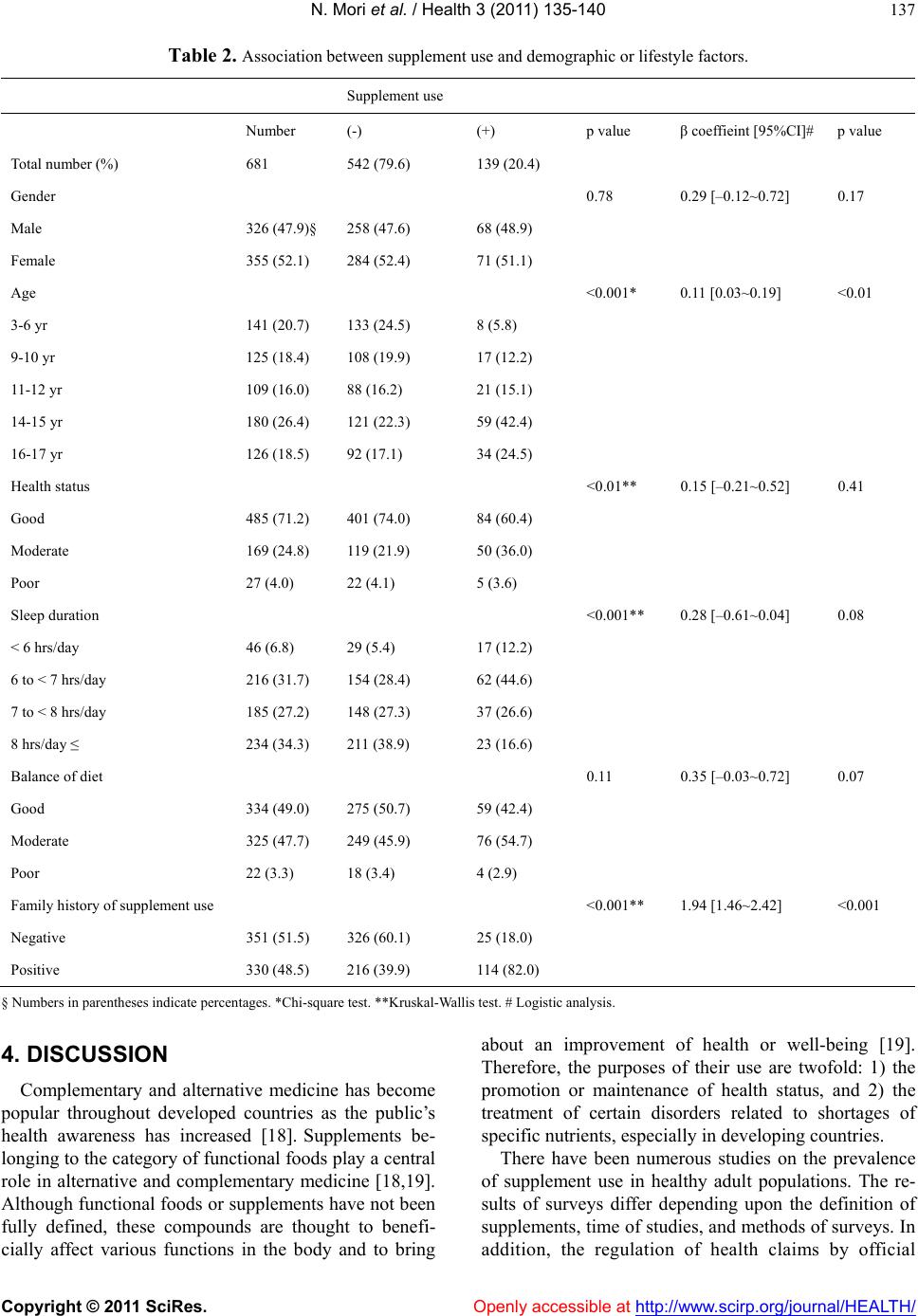 N. Mori et al. / Health 3 (2011) 135-140 Copyright © 2011 SciRes. Openl y accessible at http://www.scirp.org/journal/HEALTH/ 137 Table 2. Association between supplement use and demographic or lifestyle factors. Supplement use Number (-) (+) p value β coeffieint [95%CI]# p value Total number (%) 681 542 (79.6) 139 (20.4) Gender 0.78 0.29 [–0.12~0.72] 0.17 Male 326 (47.9)§ 258 (47.6) 68 (48.9) Female 355 (52.1) 284 (52.4) 71 (51.1) Age <0.001* 0.11 [0.03~0.19] <0.01 3-6 yr 141 (20.7) 133 (24.5) 8 (5.8) 9-10 yr 125 (18.4) 108 (19.9) 17 (12.2) 11-12 yr 109 (16.0) 88 (16.2) 21 (15.1) 14-15 yr 180 (26.4) 121 (22.3) 59 (42.4) 16-17 yr 126 (18.5) 92 (17.1) 34 (24.5) Health status <0.01** 0.15 [–0.21~0.52] 0.41 Good 485 (71.2) 401 (74.0) 84 (60.4) Moderate 169 (24.8) 119 (21.9) 50 (36.0) Poor 27 (4.0) 22 (4.1) 5 (3.6) Sleep duration <0.001** 0.28 [–0.61~0.04] 0.08 < 6 hrs/day 46 (6.8) 29 (5.4) 17 (12.2) 6 to < 7 hrs/day 216 (31.7) 154 (28.4) 62 (44.6) 7 to < 8 hrs/day 185 (27.2) 148 (27.3) 37 (26.6) 8 hrs/day ≤ 234 (34.3) 211 (38.9) 23 (16.6) Balance of diet 0.11 0.35 [–0.03~0.72] 0.07 Good 334 (49.0) 275 (50.7) 59 (42.4) Moderate 325 (47.7) 249 (45.9) 76 (54.7) Poor 22 (3.3) 18 (3.4) 4 (2.9) Family history of supplement use <0.001** 1.94 [1.46~2.42] <0.001 Negative 351 (51.5) 326 (60.1) 25 (18.0) Positive 330 (48.5) 216 (39.9) 114 (82.0) § Numbers in parentheses indicate percentages. *Chi-square test. **Kruskal-Wallis test. # Logistic analysis. 4. DISCUSSION Complementary and alternative medicine has become popular throughout developed countries as the public’s health awareness has increased [18]. Supplements be- longing to the category of functional foods play a central role in alternative and complementary medicine [18,19]. Although functional foods or supplements have not been fully defined, these compounds are thought to benefi- cially affect various functions in the body and to bring about an improvement of health or well-being [19]. Therefore, the purposes of their use are twofold: 1) the promotion or maintenance of health status, and 2) the treatment of certain disorders related to shortages of specific nutrients, especially in developing countries. There have been numerous studies on the prevalence of supplement use in healthy adult populations. The re- sults of surveys differ depending upon the definition of supplements, time of studies, and methods of surveys. In addition, the regulation of health claims by official 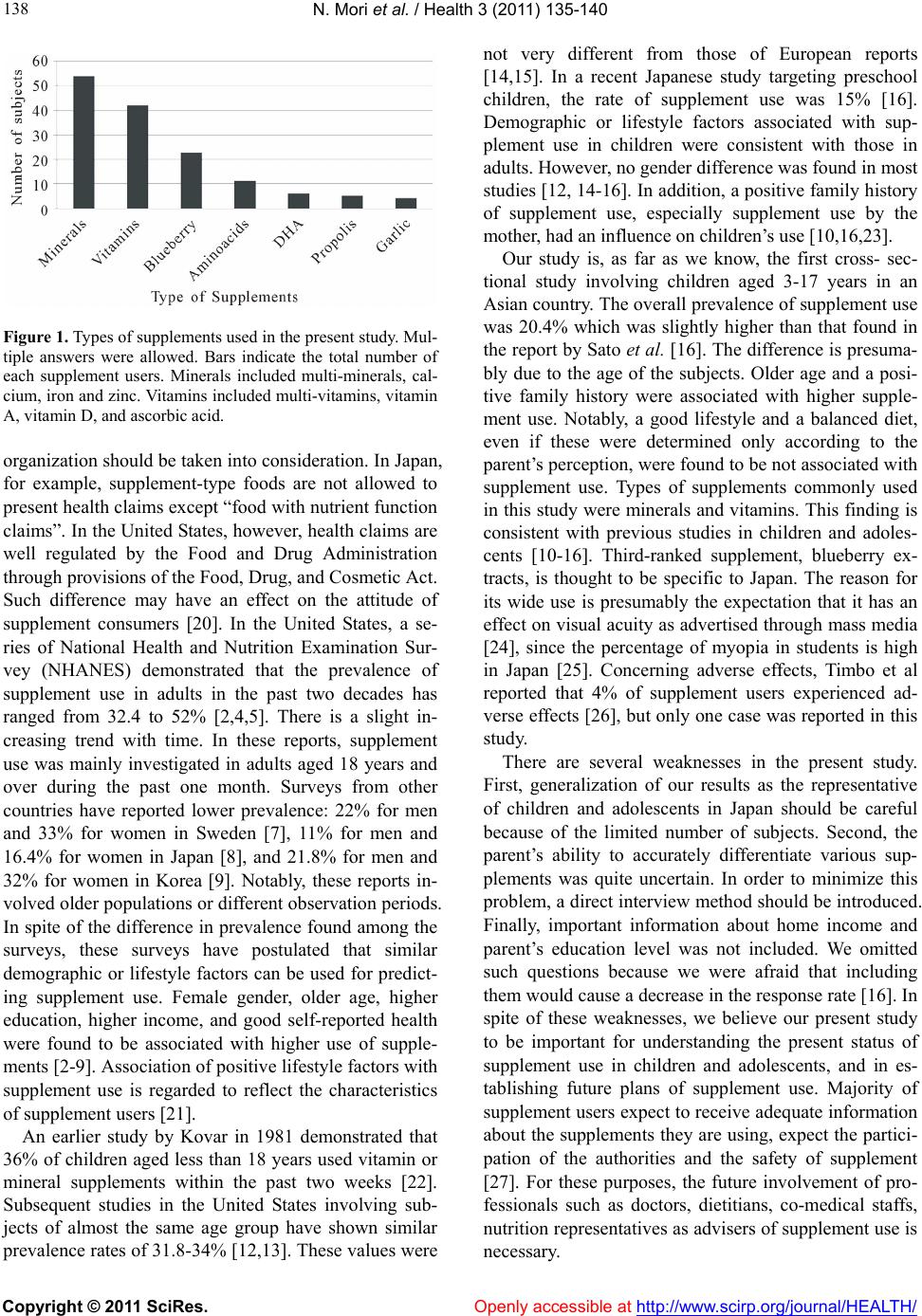 N. Mori et al. / Health 3 (2011) 135-140 Copyright © 2011 SciRes. Openl y accessible at http://www.scirp.org/journal/HEALTH/ 138 Figure 1. Types of supplements used in the present study. Mul- tiple answers were allowed. Bars indicate the total number of each supplement users. Minerals included multi-minerals, cal- cium, iron and zinc. Vitamins included multi-vitamins, vitamin A, vitamin D, and ascorbic acid. organization should be taken into consideration. In Japan, for example, supplement-type foods are not allowed to present health claims except “food with nutrient function claims”. In the United States, however, health claims are well regulated by the Food and Drug Administration through provisions of the Food, Drug, and Cosmetic Act. Such difference may have an effect on the attitude of supplement consumers [20]. In the United States, a se- ries of National Health and Nutrition Examination Sur- vey (NHANES) demonstrated that the prevalence of supplement use in adults in the past two decades has ranged from 32.4 to 52% [2,4,5]. There is a slight in- creasing trend with time. In these reports, supplement use was mainly investigated in adults aged 18 years and over during the past one month. Surveys from other countries have reported lower prevalence: 22% for men and 33% for women in Sweden [7], 11% for men and 16.4% for women in Japan [8], and 21.8% for men and 32% for women in Korea [9]. Notably, these reports in- volved older populations or different observation periods. In spite of the difference in prevalence found among the surveys, these surveys have postulated that similar demographic or lifestyle factors can be used for predict- ing supplement use. Female gender, older age, higher education, higher income, and good self-reported health were found to be associated with higher use of supple- ments [2-9]. Association of positive lifestyle factors with supplement use is regarded to reflect the characteristics of supplement users [21]. An earlier study by Kovar in 1981 demonstrated that 36% of children aged less than 18 years used vitamin or mineral supplements within the past two weeks [22]. Subsequent studies in the United States involving sub- jects of almost the same age group have shown similar prevalence rates of 31.8-34% [12,13]. These values were not very different from those of European reports [14,15]. In a recent Japanese study targeting preschool children, the rate of supplement use was 15% [16]. Demographic or lifestyle factors associated with sup- plement use in children were consistent with those in adults. However, no gender difference was found in most studies [12, 14-16]. In addition, a positive family history of supplement use, especially supplement use by the mother, had an influence on children’s use [10,16,23]. Our study is, as far as we know, the first cross- sec- tional study involving children aged 3-17 years in an Asian country. The overall prevalence of supplement use was 20.4% which was slightly higher than that found in the report by Sato et al. [16]. The difference is presuma- bly due to the age of the subjects. Older age and a posi- tive family history were associated with higher supple- ment use. Notably, a good lifestyle and a balanced diet, even if these were determined only according to the parent’s perception, were found to be not associated with supplement use. Types of supplements commonly used in this study were minerals and vitamins. This finding is consistent with previous studies in children and adoles- cents [10-16]. Third-ranked supplement, blueberry ex- tracts, is thought to be specific to Japan. The reason for its wide use is presumably the expectation that it has an effect on visual acuity as advertised through mass media [24], since the percentage of myopia in students is high in Japan [25]. Concerning adverse effects, Timbo et al reported that 4% of supplement users experienced ad- verse effects [26], but only one case was reported in this study. There are several weaknesses in the present study. First, generalization of our results as the representative of children and adolescents in Japan should be careful because of the limited number of subjects. Second, the parent’s ability to accurately differentiate various sup- plements was quite uncertain. In order to minimize this problem, a direct interview method should be introduced. Finally, important information about home income and parent’s education level was not included. We omitted such questions because we were afraid that including them would cause a decrease in the response rate [16]. In spite of these weaknesses, we believe our present study to be important for understanding the present status of supplement use in children and adolescents, and in es- tablishing future plans of supplement use. Majority of supplement users expect to receive adequate information about the supplements they are using, expect the partici- pation of the authorities and the safety of supplement [27]. For these purposes, the future involvement of pro- fessionals such as doctors, dietitians, co-medical staffs, nutrition representatives as advisers of supplement use is necessary. 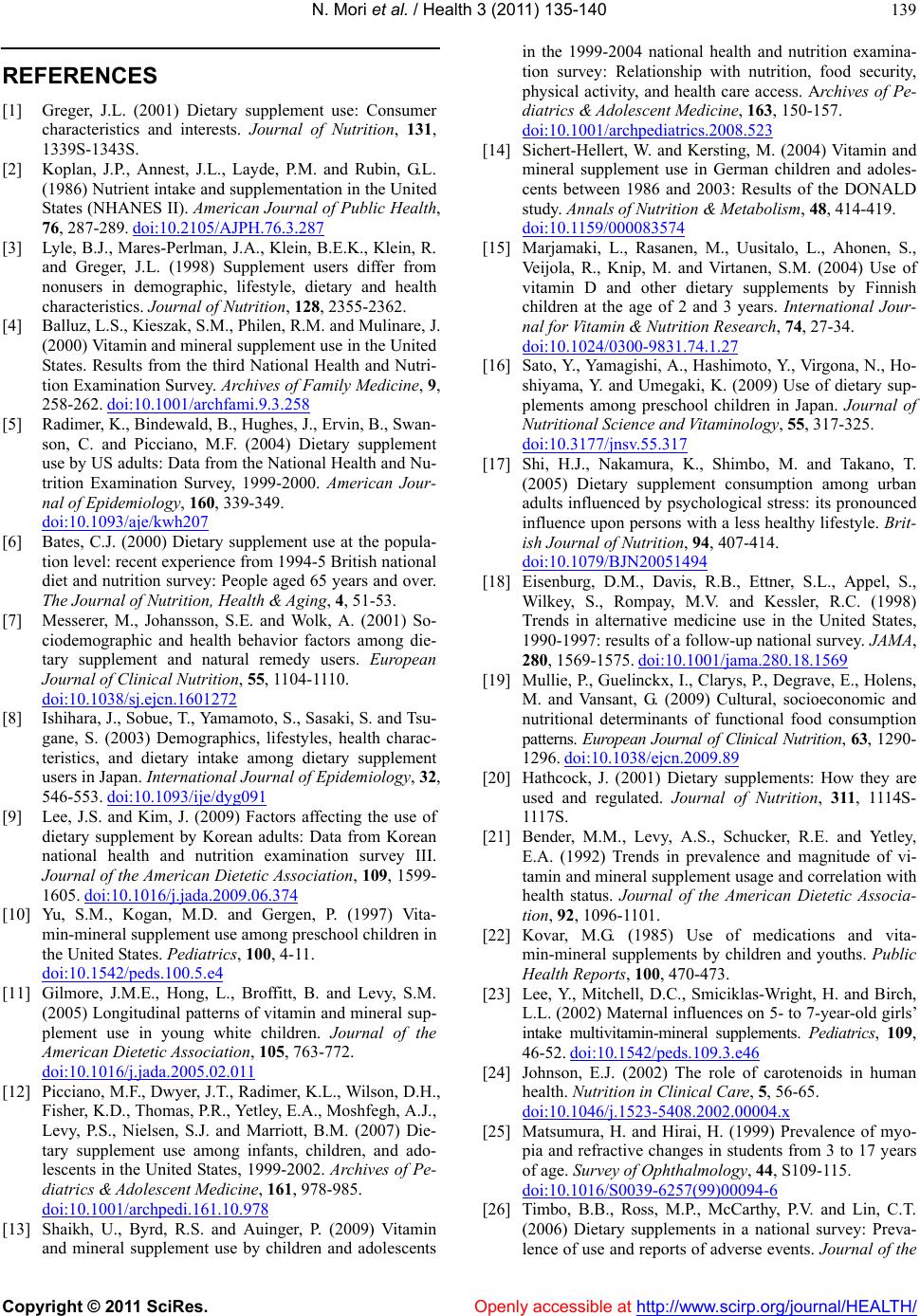 N. Mori et al. / Health 3 (2011) 135-140 Copyright © 2011 SciRes. Openl y accessible at http://www.scirp.org/journal/HEALTH/ 139 REFERENCES [1] Greger, J.L. (2001) Dietary supplement use: Consumer characteristics and interests. Journal of Nutrition, 131, 1339S-1343S. [2] Koplan, J.P., Annest, J.L., Layde, P.M. and Rubin, G.L. (1986) Nutrient intake and supplementation in the United States (NHANES II). American Journal of Public Health, 76, 287-289. doi:10.2105/AJPH.76.3.287 [3] Lyle, B.J., Mares-Perlman, J.A., Klein, B.E.K., Klein, R. and Greger, J.L. (1998) Supplement users differ from nonusers in demographic, lifestyle, dietary and health characteristics. Journal of Nutrition, 128, 2355-2362. [4] Balluz, L.S., Kieszak, S.M., Philen, R.M. and Mulinare, J. (2000) Vitamin and mineral supplement use in the United States. Results from the third National Health and Nutri- tion Examination Survey. Archives of Family Medicine, 9, 258-262. doi:10.1001/archfami.9.3.258 [5] Radimer, K., Bindewald, B., Hughes, J., Ervin, B., Swan- son, C. and Picciano, M.F. (2004) Dietary supplement use by US adults: Data from the National Health and Nu- trition Examination Survey, 1999-2000. American Jour- nal of Epidemiology, 160, 339-349. doi:10.1093/aje/kwh207 [6] Bates, C.J. (2000) Dietary supplement use at the popula- tion level: recent experience from 1994-5 British national diet and nutrition survey: People aged 65 years and over. The Journal of Nutrition, Health & Aging, 4, 51-53. [7] Messerer, M., Johansson, S.E. and Wolk, A. (2001) So- ciodemographic and health behavior factors among die- tary supplement and natural remedy users. European Journal of Clinical Nutrition, 55, 1104-1110. doi:10.1038/sj.ejcn.1601272 [8] Ishihara, J., Sobue, T., Yamamoto, S., Sasaki, S. and Tsu- gane, S. (2003) Demographics, lifestyles, health charac- teristics, and dietary intake among dietary supplement users in Japan. International Journal of Epidemiology, 32, 546-553. doi:10.1093/ije/dyg091 [9] Lee, J.S. and Kim, J. (2009) Factors affecting the use of dietary supplement by Korean adults: Data from Korean national health and nutrition examination survey III. Journal of the American Dietetic Association, 109, 1599- 1605. doi:10.1016/j.jada.2009.06.374 [10] Yu, S.M., Kogan, M.D. and Gergen, P. (1997) Vita- min-mineral supplement use among preschool children in the United States. Pediatrics, 100, 4-11. doi:10.1542/peds.100.5.e4 [11] Gilmore, J.M.E., Hong, L., Broffitt, B. and Levy, S.M. (2005) Longitudinal patterns of vitamin and mineral sup- plement use in young white children. Journal of the American Dietetic Association, 105, 763-772. doi:10.1016/j.jada.2005.02.011 [12] Picciano, M.F., Dwyer, J.T., Radimer, K.L., Wilson, D.H., Fisher, K.D., Thomas, P.R., Yetley, E.A., Moshfegh, A.J., Levy, P.S., Nielsen, S.J. and Marriott, B.M. (2007) Die- tary supplement use among infants, children, and ado- lescents in the United States, 1999-2002. Archives of Pe- diatrics & Adolescent Medicine, 161, 978-985. doi:10.1001/archpedi.161.10.978 [13] Shaikh, U., Byrd, R.S. and Auinger, P. (2009) Vitamin and mineral supplement use by children and adolescents in the 1999-2004 national health and nutrition examina- tion survey: Relationship with nutrition, food security, physical activity, and health care access. Archives of Pe- diatrics & Adolescent Medicine, 163, 150-157. doi:10.1001/archpediatrics.2008.523 [14] Sichert-Hellert, W. and Kersting, M. (2004) Vitamin and mineral supplement use in German children and adoles- cents between 1986 and 2003: Results of the DONALD study. Annals of Nutrition & Metabolism, 48, 414-419. doi:10.1159/000083574 [15] Marjamaki, L., Rasanen, M., Uusitalo, L., Ahonen, S., Veijola, R., Knip, M. and Virtanen, S.M. (2004) Use of vitamin D and other dietary supplements by Finnish children at the age of 2 and 3 years. International Jour- nal for Vitamin & Nutrition Research, 74, 27-34. doi:10.1024/0300-9831.74.1.27 [16] Sato, Y., Yamagishi, A., Hashimoto, Y., Virgona, N., Ho- shiyama, Y. and Umegaki, K. (2009) Use of dietary sup- plements among preschool children in Japan. Journal of Nutritional Science and Vitaminology, 55, 317-325. doi:10.3177/jnsv.55.317 [17] Shi, H.J., Nakamura, K., Shimbo, M. and Takano, T. (2005) Dietary supplement consumption among urban adults influenced by psychological stress: its pronounced influence upon persons with a less healthy lifestyle. Brit- ish Journal of Nutrition, 94, 407-414. doi:10.1079/BJN20051494 [18] Eisenburg, D.M., Davis, R.B., Ettner, S.L., Appel, S., Wilkey, S., Rompay, M.V. and Kessler, R.C. (1998) Trends in alternative medicine use in the United States, 1990-1997: results of a follow-up national survey. JAMA, 280, 1569-1575. doi:10.1001/jama.280.18.1569 [19] Mullie, P., Guelinckx, I., Clarys, P., Degrave, E., Holens, M. and Vansant, G. (2009) Cultural, socioeconomic and nutritional determinants of functional food consumption patterns. European Journal of Clinical Nutrition, 63, 1290- 1296. doi:10.1038/ejcn.2009.89 [20] Hathcock, J. (2001) Dietary supplements: How they are used and regulated. Journal of Nutrition, 311, 1114S- 1117S. [21] Bender, M.M., Levy, A.S., Schucker, R.E. and Yetley, E.A. (1992) Trends in prevalence and magnitude of vi- tamin and mineral supplement usage and correlation with health status. Journal of the American Dietetic Associa- tion, 92, 1096-1101. [22] Kovar, M.G. (1985) Use of medications and vita- min-mineral supplements by children and youths. Public Health Reports, 100, 470-473. [23] Lee, Y., Mitchell, D.C., Smiciklas-Wright, H. and Birch, L.L. (2002) Maternal influences on 5- to 7-year-old girls’ intake multivitamin-mineral supplements. Pediatric s, 109, 46-52. doi:10.1542/peds.109.3.e46 [24] Johnson, E.J. (2002) The role of carotenoids in human health. Nutrition in Clinical Care, 5, 56-65. doi:10.1046/j.1523-5408.2002.00004.x [25] Matsumura, H. and Hirai, H. (1999) Prevalence of myo- pia and refractive changes in students from 3 to 17 years of age. Survey of Ophthalmology, 44, S109-115. doi:10.1016/S0039-6257(99)00094-6 [26] Timbo, B.B., Ross, M.P., McCarthy, P.V. and Lin, C.T. (2006) Dietary supplements in a national survey: Preva- lence of use and reports of adverse events. Journal of the 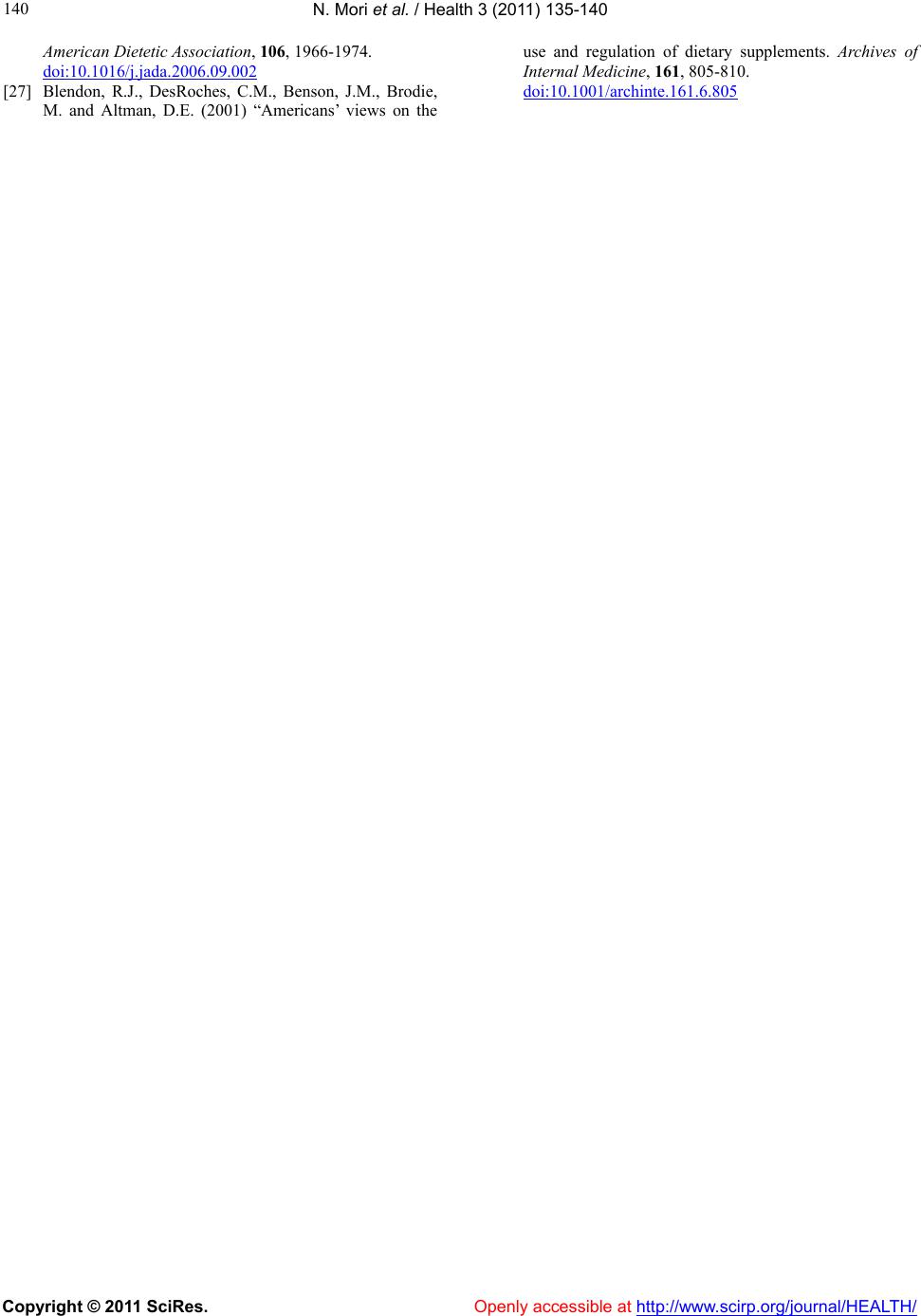 N. Mori et al. / Health 3 (2011) 135-140 Copyright © 2011 SciRes. Openl y accessible at http://www.scirp.org/journal/HEALTH/ 140 American Dietetic Association, 106, 1966-1974. doi:10.1016/j.jada.2006.09.002 [27] Blendon, R.J., DesRoches, C.M., Benson, J.M., Brodie, M. and Altman, D.E. (2001) “Americans’ views on the use and regulation of dietary supplements. Archives of Internal Medicine, 161, 805-810. doi:10.1001/archinte.161.6.805 |

